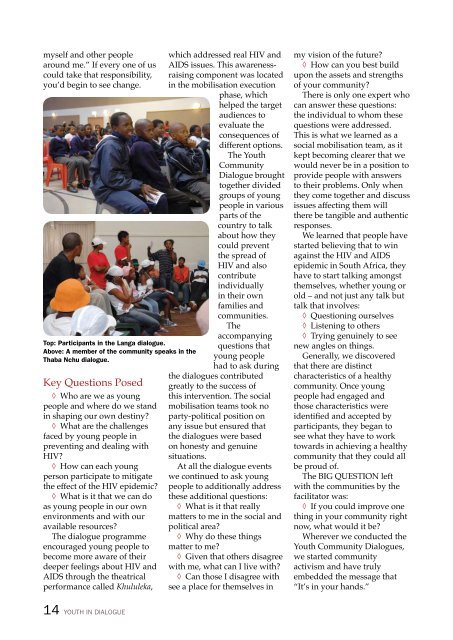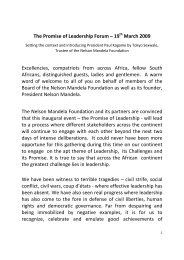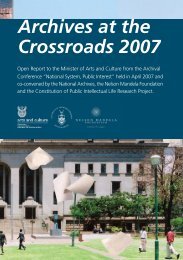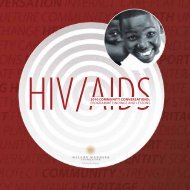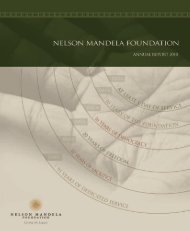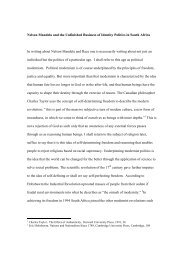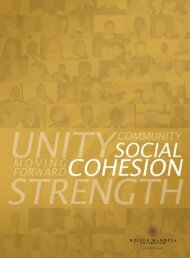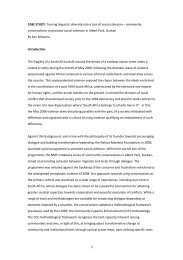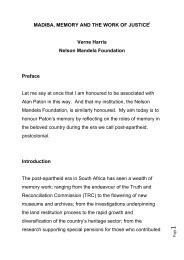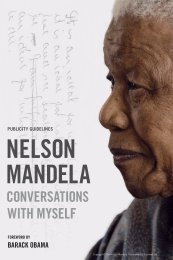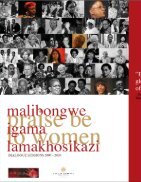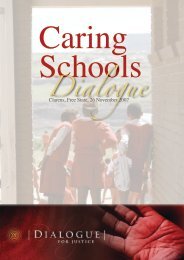Youth in Dialogue - Nelson Mandela Foundation
Youth in Dialogue - Nelson Mandela Foundation
Youth in Dialogue - Nelson Mandela Foundation
- No tags were found...
Create successful ePaper yourself
Turn your PDF publications into a flip-book with our unique Google optimized e-Paper software.
myself and other people<br />
around me.” If every one of us<br />
could take that responsibility,<br />
you’d beg<strong>in</strong> to see change.<br />
Top: Participants <strong>in</strong> the Langa dialogue.<br />
Above: A member of the community speaks <strong>in</strong> the<br />
Thaba Nchu dialogue.<br />
Key Questions Posed<br />
◊ Who are we as young<br />
people and where do we stand<br />
<strong>in</strong> shap<strong>in</strong>g our own dest<strong>in</strong>y<br />
◊ What are the challenges<br />
faced by young people <strong>in</strong><br />
prevent<strong>in</strong>g and deal<strong>in</strong>g with<br />
HIV<br />
◊ How can each young<br />
person participate to mitigate<br />
the effect of the HIV epidemic<br />
◊ What is it that we can do<br />
as young people <strong>in</strong> our own<br />
environments and with our<br />
available resources<br />
The dialogue programme<br />
encouraged young people to<br />
become more aware of their<br />
deeper feel<strong>in</strong>gs about HIV and<br />
AIDS through the theatrical<br />
performance called Khululeka,<br />
which addressed real HIV and<br />
AIDS issues. This awarenessrais<strong>in</strong>g<br />
component was located<br />
<strong>in</strong> the mobilisation execution<br />
phase, which<br />
helped the target<br />
audiences to<br />
evaluate the<br />
consequences of<br />
different options.<br />
The <strong>Youth</strong><br />
Community<br />
<strong>Dialogue</strong> brought<br />
together divided<br />
groups of young<br />
people <strong>in</strong> various<br />
parts of the<br />
country to talk<br />
about how they<br />
could prevent<br />
the spread of<br />
HIV and also<br />
contribute<br />
<strong>in</strong>dividually<br />
<strong>in</strong> their own<br />
families and<br />
communities.<br />
The<br />
accompany<strong>in</strong>g<br />
questions that<br />
young people<br />
had to ask dur<strong>in</strong>g<br />
the dialogues contributed<br />
greatly to the success of<br />
this <strong>in</strong>tervention. The social<br />
mobilisation teams took no<br />
party-political position on<br />
any issue but ensured that<br />
the dialogues were based<br />
on honesty and genu<strong>in</strong>e<br />
situations.<br />
At all the dialogue events<br />
we cont<strong>in</strong>ued to ask young<br />
people to additionally address<br />
these additional questions:<br />
◊ What is it that really<br />
matters to me <strong>in</strong> the social and<br />
political area<br />
◊ Why do these th<strong>in</strong>gs<br />
matter to me<br />
◊ Given that others disagree<br />
with me, what can I live with<br />
◊ Can those I disagree with<br />
see a place for themselves <strong>in</strong><br />
my vision of the future<br />
◊ How can you best build<br />
upon the assets and strengths<br />
of your community<br />
There is only one expert who<br />
can answer these questions:<br />
the <strong>in</strong>dividual to whom these<br />
questions were addressed.<br />
This is what we learned as a<br />
social mobilisation team, as it<br />
kept becom<strong>in</strong>g clearer that we<br />
would never be <strong>in</strong> a position to<br />
provide people with answers<br />
to their problems. Only when<br />
they come together and discuss<br />
issues affect<strong>in</strong>g them will<br />
there be tangible and authentic<br />
responses.<br />
We learned that people have<br />
started believ<strong>in</strong>g that to w<strong>in</strong><br />
aga<strong>in</strong>st the HIV and AIDS<br />
epidemic <strong>in</strong> South Africa, they<br />
have to start talk<strong>in</strong>g amongst<br />
themselves, whether young or<br />
old – and not just any talk but<br />
talk that <strong>in</strong>volves:<br />
◊ Question<strong>in</strong>g ourselves<br />
◊ Listen<strong>in</strong>g to others<br />
◊ Try<strong>in</strong>g genu<strong>in</strong>ely to see<br />
new angles on th<strong>in</strong>gs.<br />
Generally, we discovered<br />
that there are dist<strong>in</strong>ct<br />
characteristics of a healthy<br />
community. Once young<br />
people had engaged and<br />
those characteristics were<br />
identified and accepted by<br />
participants, they began to<br />
see what they have to work<br />
towards <strong>in</strong> achiev<strong>in</strong>g a healthy<br />
community that they could all<br />
be proud of.<br />
The BIG QUESTION left<br />
with the communities by the<br />
facilitator was:<br />
◊ If you could improve one<br />
th<strong>in</strong>g <strong>in</strong> your community right<br />
now, what would it be<br />
Wherever we conducted the<br />
<strong>Youth</strong> Community <strong>Dialogue</strong>s,<br />
we started community<br />
activism and have truly<br />
embedded the message that<br />
“It’s <strong>in</strong> your hands.”<br />
14 YOUTH IN DIALOGUE


